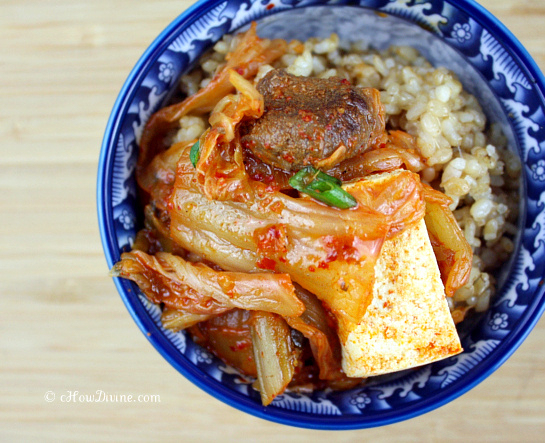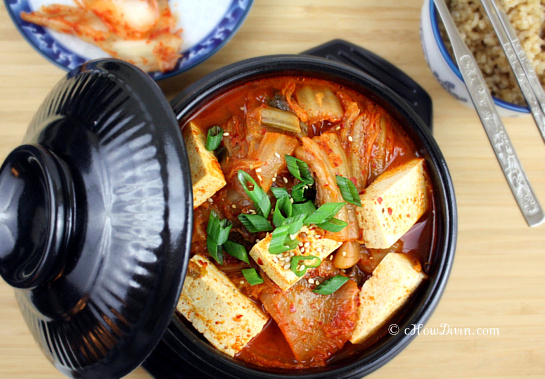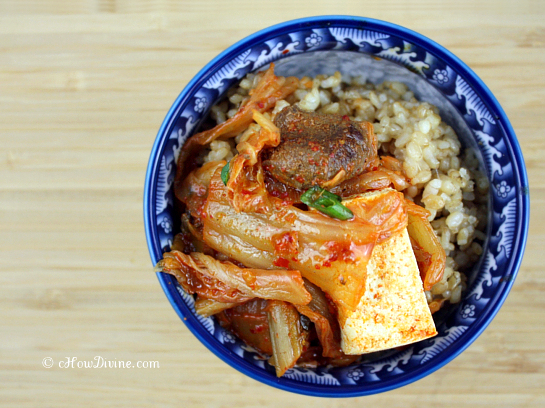I didn’t cook much as a college student. It was mostly dorm food, cheap takeout, or whatever was on sale – preferably instant – at the market. But there was one thing I made that I was proud of: Kimchi Jjigae (Kimchi Stew). Truthfully, the end result had very little to do with my limited skills at the time. It’s really difficult to mess up Kimchi Jjigae. As long as you have some decent kimchi that is slightly beyond its prime (sour kimchi), the simmering does all of the work in bringing the flavors together. Nevertheless, I felt like a great cook whenever I made this and lapped up all the praise that came my way.
My cooking skills have much improved, and my culinary repertoire has considerably expanded over the years. However, I still like my recipes simple, quick, and/or delicious even when reheated. This is especially important during the weekdays when dinners go by like a blur. I can’t cook anything that takes more than 20-30 minutes. This would be a problem for someone like me – someone who could survive on slowly simmered stews or braises alone in the winter. Luckily, stews generally keep well, and many taste even better when reheated. I just cook up a big pot of stew on the weekend and enjoy the leftovers during the week. This is one of the reasons why I still make Kimchi Jjigae often.
Kimchi Jjigae is one of the easiest stews you can make. Of course, you can always complicate it; BUT WHY? Just throw in all of the ingredients together (except for tofu) and simmer. Seriously, it is THAT easy. And believe me, it will taste better than your typical restaurant’s version of Kimchi Jjigae. Added bonus: you won’t have to drink buckets of water afterwards. I don’t know why, but restaurant-bought stews and soups are generally so salty! The extra salt doesn’t make the stew taste any better. And I always regret ordering it soon after.
An added benefit to kimchi jjigae is that it actually tastes better when reheated. I NEVER toss leftover kimchi jjigae, even if I only have a small amount left. I just add a little bit of water and gochujang, along with some extra kimchi if you’d like. Just reheat it and enjoy. It’s great just with some steamed rice; and if you have some time and/or energy, fry up an egg and plop it on the rice. The runny yolk tastes so good with the stew. My mouth is watering just thinking about it.
Kimchi Jjigae (Kimchi Stew) Recipe
Serves 4 people
Ingredients
1/2 lb beef or pork cubed
3 cups napa cabbage kimchi
2 cups water
1 heaping TB gochujang (Korean chili pepper paste)*
8 oz tofu sliced into rectangles or cubed
< 1 tsp sugar (optional)
1 TB mirin (optional)
1/2 - 1 TB canola or grapeseed oil
- Place a pot on moderately high heat. Spread the oil and meat at the bottom of the pot. Add napa cabbage kimchi, water, gochujang, and sugar. Bring the ingredients to a boil and turn down the heat to simmer. Simmer for at least 45 minutes. Leave the lid tilted or leave the vent of the lid open. You want the stew to thicken up a bit. You can always add more water if needed. Add tofu and mirin (if using) towards the end of cooking.
- Serve with some steamed rice. Garnish with a chopped green onions if desired.
Cook’s Note:
You can sear the meat with oil before adding the other ingredients. I usually skip this step in the interest of time (translation: I’m usually lazy). Besides, the flavor of the stew isn’t at all sacrificed.
Add the oil even if you are not searing the meat. It makes a difference in taste, especially if you are using a leaner cut of meat. Cuts with a bit of fat are better for the stew.
I don’t use the kimchi juice, because I find that the taste is “cleaner” without it. If you choose to add it, be mindful that it will make the stew saltier; so reduce the amount of gochujang. *BUT if you don’t have any gochujang, add some kimchi juice and make sure you add the sugar. I use light brown sugar or sucanat.
If you have any sliced tteok (Korean rice cakes), throw in a handful with about 5 minutes left of cooking. They are VERY very good in the stew!





i like anchovy and dashima for the broth along with a little pork instead of beef. i don’t like too much juice in either.
Yeah, it’s nice with some anchovy & dashima broth. But this stew is more of a meat/kimchi stew at its simplest form. No frills and minimal prep. Just the way I like (need) it. 🙂 Thanks for coming by the site jasi!
Kimchi Jigae is my favorite dish. My mouth is watering now.
Thank you! One of mine too. 🙂
Hello, what kind of beef should I buy to make the soup with? There are so many different kinds and I’m a novice cook. Do I need to buy tenderloin?
You can use many different cuts of beef or pork. You can even use pork belly if you’d like. I personally prefer this stew with beef and usually use what I have on hand; that can be chuck, round, or tenderloin. Tenderloin is, of course, an expensive cut of meat, and I would only use it if that’s the only type of meat in my fridge (and too lazy to run to the store). 🙂
This is one of my favorite dishes. Thank you for the simple recipe. I will be making this soon!
You’re welcome Nicole! I hope you like it. It’s one of my favorite things to eat when it’s cold outside. So comforting! 🙂
Oh dear…my mouth is watering looking at your pictures and wishing that I have Kimchi Jjigae in my fridge right now. I actually have in my fridge probably over 3 months old kimchi and everything in the ingredient list-maybe it’s time for me to make this asap. Have a wonderful night!
Thank you Sandra! That kimchi sounds perfect for the stew! Have a wonderful rest of the week AND birthday!!! 😀
MADE IT and LOVED IT!!!!! I wish I had tteok to add but maybe next time I will have more time to look for it….Thank you for the recipe!
Yay, so glad you tried it Sandra! Tteok is my husband’s favorite part of the soup. Thank you for letting me know how it turned out! 🙂
Oh boy, this looks so good! My husband LOVES spicy food and he truly enjoys this dish. I on the other hand cannot handle spicy food (it’s more like my stomach) so I haven’t had a chance to enjoy delicious spicy food… 🙁 I’m missing out big time. This is such a comfort food. I’m so jealous of everyone who enjoy this dish!
I totally understand about the stomach issues! I feel like there are more dishes I can’t digest than digest sometimes. But there’s so much yummy food in the world, you just have more time to eat other types of yummy foods! 🙂
Gotta love the simplicity and tastiness of Korean food. Gouchujang and kimchi are secret weapons! I’ll give this a try, looking forward to it!
Gotta agree with you there Jonny! There are so many things you can make with those ingredients. Have you ever had kimchi jjigae? If you haven’t, make sure the stew thickens up a bit (allow it to reduce it a little). That’s how I like it. 🙂 Thanks for coming by the site!
this might be an obvious question, but at what point do you add the tofu?
Hi Ale! If you’ve never tried making Kimchi Jjigae, it is not obvious at all! 🙂 I add it with about 10 minutes or less left of cooking, because I like the taste of tofu that is still fresh. Some people like them more cooked in the Jjigae and more flavored. Try putting the tofu in with 10 minutes left of cooking. See how you like it. If you like the taste of fresh tofu in salads, that should do it. Thanks for coming by the site and let me know if you have other questions!
Consider me a Korean food newbie, but when I order kimchi jjigae at a restaurant, there is always this chewy white disk with a reddish outer ring mixed into the stew. What is that? It’s actually one of my favorite tidbits in the dish. I want to undertake this dish at home (I bought pork belly last night), and it wouldn’t be the same for me without it.
Hi Pam, those chewy disks aren’t really Korean at all! They are Japanese in origin. They are called Kamaboko (Japanese), Eomuk (pronounced uh-mook, Korean), or Odeng (Korean). You probably like them because you are quite familiar with the taste. The fake/imitation crab in Cali rolls? Yup, it’s in the same family. 🙂 We used to eat them a lot when I was young – in soups, stir-fries, and gimbap mainly. We stopped eating them because of the MSG content. But if you like them, you can go to any Japanese or Korean market and ask for them. They do taste good!
Thank you for coming by the site. Let me know if you have any other questions! 😀
I kind of ended up making mine a soup with an extra cup of water along with the rice cakes and enoki mushrooms… and it’s delicious!
Thank you for sharing this recipe! I can’t wait to make it again without so much liquid 🙂
I’m glad you liked it May! I LOVE rice cakes in this jjigae. And the enoki mushrooms sound yummy! Some people like their jjigae a little bit more soupy. I just happen to like the concentrated flavor of kimchi and meat. 😀 Thank you for coming by the site and letting me know how it turned out!
hi! i would like to try making kimchi jjage but is it ok if i didnt put kochukaru? because i saw some recipe they insert kochukaru as well…
Hi Pei Ru! Korean cooking is a very imprecise art. Most families have different ways of making almost all dishes. So yes, you can add gochugaru to the jjigae if you’d like. But you have to keep in mind, gochugaru will be present in the kimchi. If you are using kimchi that is already smothered in gochugaru (which some store-bought kimchi brands are), your added gochugaru may make the soup may feel “muddy.” I personally like to add gochujang because of it’s earthiness and a bit of sweetness. If you are planning to add gochugaru, start by adding just a little bit (like a teaspoon) and add more if you feel the need.
All that to say, yes, you can add gochugaru. 🙂 I hope this helps!
Wow…ur recipe looks so easy and perfect for those busy nights when there is not a lot of time to cook. My Kimchi Jjigae is a bit more complicated with more steps and ingredients..yes, I make it complicated lol..
As easy as Kimchi Jjigae can be, the first time I tried to make it (over a decade ago), it was a disaster. It tasted so bland, like Kimchi was just thrown into a pot of water. But years later through trial-and-error, I learned how to make it properly. I love spicy, so mine tends to be a bit spicier than most. I add jalapeños for an extra kick.
Thank you Miss Kim! That’s what I love about Korean cuisine. Almost all dishes can be adjusted to people’s tastes and situations. I usually have all of 15 minutes to cook dinner at night. So I’ve adjusted accordingly. My SIL is a total spicy-food nut as well. So she puts jalapeños or even spicier peppers in everything! Thanks for coming by the site!
Amazing recipe. I added tteok and enoki mushrooms and it was sublime. Thanks for sharing, gomo!
Thank you so much for letting me know how it turned out! I’m so glad you enjoyed the jjigae. I have to work late tonight, and reading your comment is really making me crave kimchi jjigae with some tteok. It makes a really good midnight snack. 😀 I hope you had a wonderful weekend Rich!
Kimchi Jjigae is one of my favorite korean dishes. Tried this out the first time.. And turned out great..:) . Thank you for sharing this recipe.
Thanks so much for letting me know how the recipe worked out for you! So glad to hear that you enjoyed it. Kimchi Jjigae is one of my favorite dishes as well. It’s so comforting. 🙂 Have a great weekend!
Looks absolutely delicious! Can’t wait to try this at home.
Thank you Joseph! Let me know how it turns out!
love it. making it for the third time… would you recommend adding any veggies to it? also, what if i do not have the korean pepper paste this time around – would the flavors still work?
I’m so glad you like the recipe! Thank you for letting us know. You can chop up about 1/2 of an onion and throw it in with the kimchi. But generally speaking, veggies aren’t added to this dish. You want the flavor to be pretty concentrated. So addition of veggies will dilute the flavor. If you don’t have any gochujang, you can still make it. Just add some kimchi juice. If you go this route, make sure to add the (brown) sugar. The flavor won’t be the same but still pretty good. Hope this helps!
Is TB for tablespoon?
Hi Rechelle,
Yes, TB is for tablespoon.
Hi! I just made this and it tastes amazing! I was wondering how to store it? Should I just refrigerate it and reheat on the stove when I want to eat it again?
Hi Jocelyn, you can refrigerate it. Just reheat it on the stovetop when you are ready to consume it (although I’ve been guilty of eating it straight out of the fridge). Thanks for sharing how it turned out!